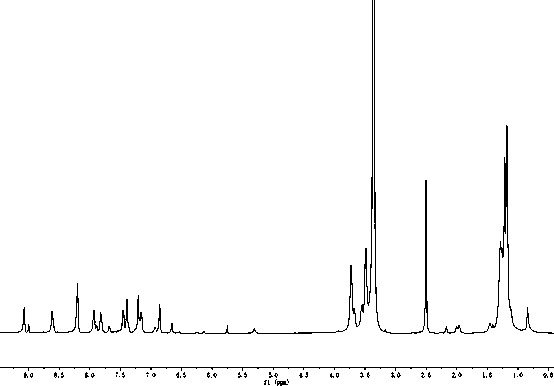Deep infrared ratio type fluorescent probe capable of quickly responding to sulfur dioxide
A fluorescent probe and fast-response technology, applied in the field of fluorescent probes, can solve problems such as expensive instruments, complicated operation steps, and long response time, and achieve high selectivity and strong fluorescence emission effects
- Summary
- Abstract
- Description
- Claims
- Application Information
AI Technical Summary
Problems solved by technology
Method used
Image
Examples
Embodiment 1
[0024] Example 1 Synthesis of probe
[0025] 0.2 g of compound Cou-Acetyl and 0.18 g of 4-diethylaminosalicylic aldehyde were dissolved in 2.9 ml of concentrated sulfuric acid. The above system was stirred and refluxed at 90 degrees Celsius for 8 hours. After the reaction, it was cooled to room temperature, and 2.9 ml of high chlorine was added dropwise. Acid, add 50 ml of ice water, filter with suction and wash with ice water, and purify the obtained suction filtrate by column chromatography to obtain blue-purple solid probe 1, with a yield of 80%. figure 1 Is the NMR image of the probe.
Embodiment 2
[0026] Example 2 Selective analysis of probes
[0027] A mixture of EtOH and HEPES with a volume ratio of 1:9 containing 10 μmol / L probe 1 was added to a sodium bisulfite solution with a concentration of 200 μmol / L at one time to detect the change in fluorescence of the solution. The result is figure 2 , When the excitation light wavelength is 470nm, the probe is very sensitive to NaHSO 3 There is a strong orange fluorescence at 610nm, and the probe has no obvious response to other anions, cations, and sulfhydryl amino acids. It shows that the probe has excellent selectivity to sulfur dioxide.
Embodiment 3
[0028] Example 3 Analysis of probe response to changes in sulfur dioxide concentration
[0029] Add different concentrations of sodium bisulfite solution to a 1:9 mixture of EtOH and HEPES containing 10 μmol / L of probe 1, and use 470nm and 654nm for excitation. Probe 1 is at 610nm and 690nm. The ratio of the fluorescence intensity at the position changes regularly with the increase of the amount of sodium bisulfite. Such as image 3 with 4 , Indicating that the probe can respond sensitively to changes in the concentration of sodium bisulfite under the excitation of two wavelengths of light.
PUM
 Login to View More
Login to View More Abstract
Description
Claims
Application Information
 Login to View More
Login to View More - R&D
- Intellectual Property
- Life Sciences
- Materials
- Tech Scout
- Unparalleled Data Quality
- Higher Quality Content
- 60% Fewer Hallucinations
Browse by: Latest US Patents, China's latest patents, Technical Efficacy Thesaurus, Application Domain, Technology Topic, Popular Technical Reports.
© 2025 PatSnap. All rights reserved.Legal|Privacy policy|Modern Slavery Act Transparency Statement|Sitemap|About US| Contact US: help@patsnap.com



